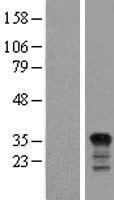PIG3 (TP53I3) (NM_147184) Human Tagged ORF Clone
CAT#: RC224067
TP53I3 (Myc-DDK-tagged)-Human tumor protein p53 inducible protein 3 (TP53I3), transcript variant 2
"NM_147184" in other vectors (4)
Specifications
| Product Data | |
| Type | Human Tagged ORF Clone |
| Tag | Myc-DDK |
| Symbol | TP53I3 |
| Synonyms | PIG3 |
| Vector | pCMV6-Entry |
| E. coli Selection | Kanamycin (25 ug/mL) |
| Mammalian Cell Selection | Neomycin |
| Sequence Data |
>RC224067 ORF sequence
Red=Cloning site Blue=ORF Green=Tags(s) TTTTGTAATACGACTCACTATAGGGCGGCCGGGAATTCGTCGACTGGATCCGGTACCGAGGAGATCTGCC GCCGCGATCGCC ATGTTAGCCGTGCACTTTGACAAGCCGGGAGGACCGGAAAACCTCTACGTGAAGGAGGTGGCCAAGCCGA GCCCGGGGGAGGGTGAAGTCCTCCTGAAGGTGGCGGCCAGCGCCCTGAACCGGGCGGACTTAATGCAGAG ACAAGGCCAGTATGACCCACCTCCAGGAGCCAGCAACATTTTGGGACTTGAGGCATCTGGACATGTGGCA GAGCTGGGGCCTGGCTGCCAGGGACACTGGAAGATCGGGGACACAGCCATGGCTCTGCTCCCCGGTGGGG GCCAGGCTCAGTACGTCACTGTCCCCGAAGGGCTCCTCATGCCTATCCCAGAGGGATTGACCCTGACCCA GGCTGCAGCCATCCCAGAGGCCTGGCTCACCGCCTTCCAGCTGTTACATCTTGTGGGAAATGTTCAGGCT GGAGACTATGTGCTAATCCATGCAGGACTGAGTGGTGTGGGCACAGCTGCTATCCAACTCACCCGGATGG CTGGAGCTATTCCTCTGGTCACAGCTGGCTCCCAGAAGAAGCTTCAAATGGCAGAAAAGCTTGGAGCAGC TGCTGGATTCAATTACAAAAAAGAGGATTTCTCTGAAGCAACGCTGAAATTCACCAAAGGTGCTGGAGTT AATCTTATTCTAGACTGCATAGGCGGATCCTACTGGGAGAAGAACGTCAACTGCCTGGCTCTTGATGGTC GATGGGTTCTCTATGGTCTGATGGGAGGAGGTGACATCAATGGGCCCCTGTTTTCAAAGCTACTTTTTAA GCGAGGAAGTCTGATCACCAGTTTGCTGAGGTCTAGGGACAATAAGTACAAGCAAATGCTGGTGAATGCT TTCACGGAGCAAATTCTGCCTCACTTCTCCACGGAGGGCCCCCAACGTCTGCTGCCGGTTCTGGACAGAA TCTACCCAGTGACCGAAATCCAGGAGGCCCATAAGTACATGGAGGCCAACAAGAACATAGGCAAGATCGT CCTGGAACTGCCCCAG ACGCGTACGCGGCCGCTCGAGCAGAAACTCATCTCAGAAGAGGATCTGGCAGCAAATGATATCCTGGATT ACAAGGATGACGACGATAAGGTTTAA >RC224067 protein sequence
Red=Cloning site Green=Tags(s) MLAVHFDKPGGPENLYVKEVAKPSPGEGEVLLKVAASALNRADLMQRQGQYDPPPGASNILGLEASGHVA ELGPGCQGHWKIGDTAMALLPGGGQAQYVTVPEGLLMPIPEGLTLTQAAAIPEAWLTAFQLLHLVGNVQA GDYVLIHAGLSGVGTAAIQLTRMAGAIPLVTAGSQKKLQMAEKLGAAAGFNYKKEDFSEATLKFTKGAGV NLILDCIGGSYWEKNVNCLALDGRWVLYGLMGGGDINGPLFSKLLFKRGSLITSLLRSRDNKYKQMLVNA FTEQILPHFSTEGPQRLLPVLDRIYPVTEIQEAHKYMEANKNIGKIVLELPQ TRTRPLEQKLISEEDLAANDILDYKDDDDKV |
| Chromatograms |
CHROMATOGRAMS
 Sequencher program is needed, download here. |
| Restriction Sites |
SgfI-MluI
Cloning Scheme for this gene
Plasmid Map

|
| ACCN | NM_147184 |
| ORF Size | 996 bp |
| OTI Disclaimer | The molecular sequence of this clone aligns with the gene accession number as a point of reference only. However, individual transcript sequences of the same gene can differ through naturally occurring variations (e.g. polymorphisms), each with its own valid existence. This clone is substantially in agreement with the reference, but a complete review of all prevailing variants is recommended prior to use. More info |
| OTI Annotation | This clone was engineered to express the complete ORF with an expression tag. Expression varies depending on the nature of the gene. |
| Product Components | The ORF clone is ion-exchange column purified, transfection-ready dried plasmid DNA, and shipped with 2 vector sequencing primers. |
| Reconstitution | 1. Centrifuge at 5,000xg for 5min. 2. Carefully open the tube and add 100ul of sterile water to dissolve the DNA. 3. Close the tube and incubate for 10 minutes at room temperature. 4. Briefly vortex the tube and then do a quick spin (less than 5000xg) to concentrate the liquid at the bottom. 5. Store the suspended plasmid at -20°C. The DNA is stable for at least one year from date of shipping when stored at -20°C. |
| Reference Data | |
| RefSeq | NM_147184.1, NM_147184.2, NM_147184.3, NP_671713.1 |
| RefSeq Size | 1643 bp |
| RefSeq ORF | 999 bp |
| Locus ID | 9540 |
| Protein Families | Druggable Genome |
| Protein Pathways | p53 signaling pathway |
| MW | 35.5 kDa |
| Gene Summary | The protein encoded by this gene is similar to oxidoreductases, which are enzymes involved in cellular responses to oxidative stresses and irradiation. This gene is induced by the tumor suppressor p53 and is thought to be involved in p53-mediated cell death. It contains a p53 consensus binding site in its promoter region and a downstream pentanucleotide microsatellite sequence. P53 has been shown to transcriptionally activate this gene by interacting with the downstream pentanucleotide microsatellite sequence. The microsatellite is polymorphic, with a varying number of pentanucleotide repeats directly correlated with the extent of transcriptional activation by p53. It has been suggested that the microsatellite polymorphism may be associated with differential susceptibility to cancer. Alternatively spliced transcript variants encoding different isoforms have been found for this gene. [provided by RefSeq, May 2011] |
Documents
| Product Manuals |
| FAQs |
Resources
Other Versions
| SKU | Description | Size | Price |
|---|---|---|---|
| SC306303 | TP53I3 (untagged)-Human tumor protein p53 inducible protein 3 (TP53I3), transcript variant 2 |
USD 660.00 |
|
| RG224067 | TP53I3 (GFP-tagged) - Human tumor protein p53 inducible protein 3 (TP53I3), transcript variant 2 |
USD 460.00 |
|
| RC224067L3 | Lenti ORF clone of Human tumor protein p53 inducible protein 3 (TP53I3), transcript variant 2, Myc-DDK-tagged |
USD 620.00 |
|
| RC224067L4 | Lenti ORF clone of Human tumor protein p53 inducible protein 3 (TP53I3), transcript variant 2, mGFP tagged |
USD 620.00 |
{0} Product Review(s)
Be the first one to submit a review






























































































































































































































































 Germany
Germany
 Japan
Japan
 United Kingdom
United Kingdom
 China
China




